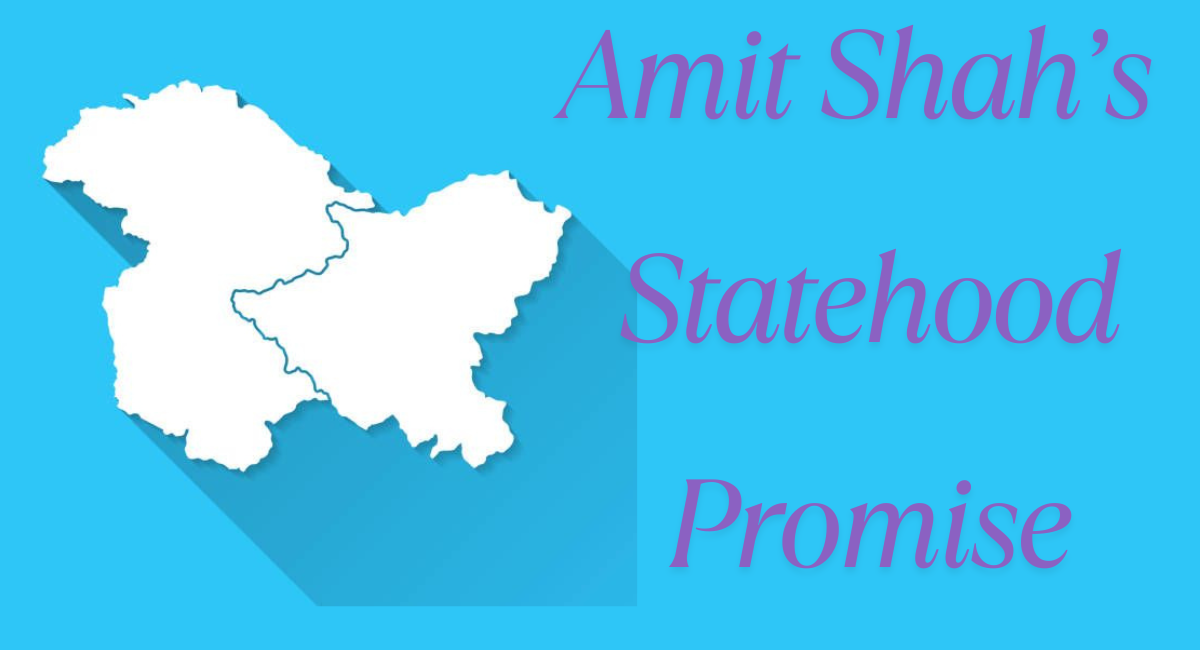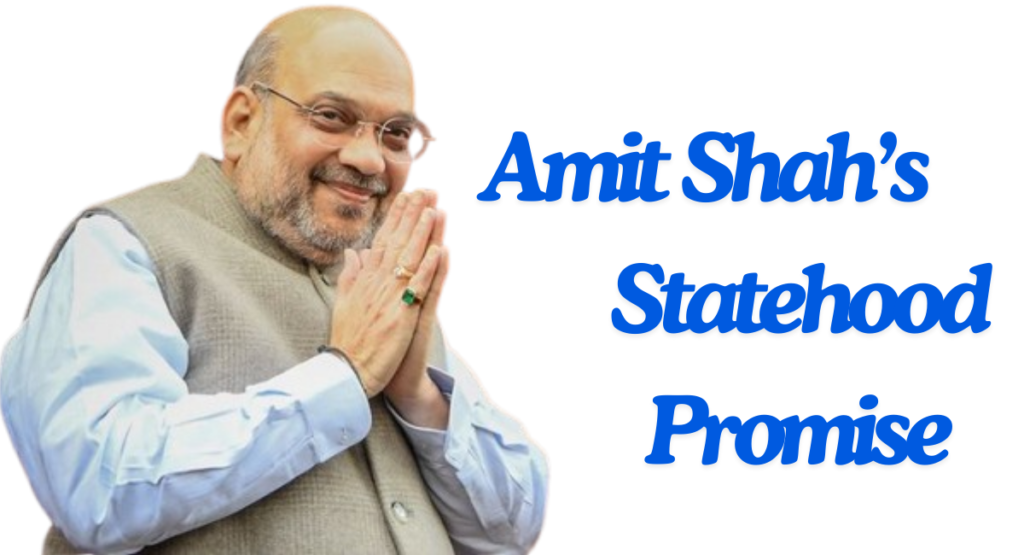On March 29, 2025, Union Home Minister Amit Shah once more launched a discourse that has been standing longer than five years within the boundary of Jammu and Kashmir. Such is the engorgement of his words-“Statehood will be restored at an appropriate time”-which were reminiscent of a promise, much awaited and long delayed for-that region torn from its autonomous status in 2019.
It would be a glimpse of hope for many in an uncertain land; for others, an inchoate, ambiguous assurance that provokes more questions than answers. When J&K is plunged back into a national debate on politics, trust, and future by Amit Shah’s statehood promise, it revives politics in the national debate.
Reinstated as a Union Territory since the revocation of Article 370, J&K is now directly controlled by the center and, therefore, its people have had to live with the harsh realities of not having rights as a full-fledged state to legislate. Shah’s statement acquires even more significance under these circumstances because, at this juncture, there are heightened security operations and a tenuous but delicate political balance.
Could this actually be reconciliation in action, or merely a sop to quell tempers without meaningful concession of power? Well, this blog wants to dig into the motivations behind Amit Shah’s statehood promise, what he actually said, how it has been interpreted, and whether it can really change the destiny of J&K.
The Backbone of Amit Shah's Promise of Statehood
The history of Jammu and Kashmir has, in fact, thus far been a narrative of the journey that began on the fateful 5th of August, 2019, with the Government of India abrogating Article 370 and extinguishing its special status.
By the stroke of this move, Jammu and Kashmir ceased to be a state with its own constitution and became a Union Territory, administered directly by New Delhi through a Lieutenant Governor. To some, this was a bold step to integrate; others, especially Kashmiris, viewed it as a loss of identity.
Increasingly in the light of this landmark development, Amit Shah’s promise of statehood would stand as an acknowledgment of a grievance and aspiration that lingers on.
The idea of restoring statehood is not new. Since 2019, BJP leaders, including Shah, have spoken about it as a future goal while attaching it to vague conditions like “restoring normalcy.”
The abrogation split up J&K into two Union Territories, J&K and Ladakh, with the former left with a partially empowered Assembly but not real autonomy. Over the years, with security crackdowns and elections, the region has been kept on a constant pulse. It has made statehood appear like a carrot dangling across its rugged terrain. Shah’s latest promise builds on this narrative, suggesting progress while keeping the reins firmly in control.
Timing is of utmost importance. In early 2025, the very region of J&K was the theatre of an array of happenings-a one-sided bloody anti-militancy operation in Kathua, a new budget presented in assembly by Chief Minister Omar Abdullah, and continuing economic woes.
Amit Shah‘s promise of statehood comes at a moment when the central government is engaged in an advertisement blitz, one of partition with equal measure of the control over those vacuums and the empathy for those abandoned. It is appeasement for those who demand empowerment and reassurance for those who plead stability as proof of success. And yet, roots run deep, inscribed in history and entrenched in politics.
The Real Words of Amit Shah
On March 29, 2025, Amit Shah addressed a gathering in New Delhi, offering a lifeline to J&K’s statehood debate. “The process of restoring statehood to Jammu and Kashmir is underway,” he declared, adding, “It will happen at an appropriate time.”
He pointed to signs of progress, like two Hurriyat factions stepping back from separatism, as evidence of a changing tide. For a region weary of promises, these words carried a glimmer of possibility—statehood might not be a distant dream after all.
But there’s a catch: Shah didn’t specify when this “appropriate time” would come. His statement was less a roadmap and more a reassurance, leaving room for interpretation.
He framed it as a triumph of the Modi government’s policies, suggesting that declining militancy and separatism have paved the way. Yet, without a timeline or concrete steps, Amit Shah’s statehood promise feels like a half-drawn sketch—intriguing but incomplete. It’s a pledge that invites both optimism and scrutiny.
Shah’s tone was confident, even defiant, as he contrasted today’s J&K with its turbulent past. He didn’t mention specifics like the powers a restored state would wield or how it would differ from the current setup.
This ambiguity is key: it keeps the central government in the driver’s seat while dangling hope before a restless population. What he said matters, but what he didn’t say might matter more.
Responses to the Promise of Statehood by Amit Shah
Amit Shah’s statehood promise is being welcomed within the BJP fold. Party leaders believe it is proof of their commitment to integrating and developing J&K.
They contend that five years of direct rule have acted against violence and separatism, thus allowing this step to be taken. For them, it is Shaw taking a victory lap—an indicator that their vision is working. Supporters cite security successes, including the Kathua operation, to argue that the region can begin a controlled return to statehood.
But opinions are not unanimous. Omar Abdullah, the Chief Minister of J&K and a leader of the National Conference, said unless there is a deadline, the promise remains “hollow.” “We’ve heard this before,” he said, reflecting a sentiment among many in the Valley.
Mehbooba Mufti’s PDP chimed in with similar thoughts, alleging that this is mere political posturing designed to create an illusion of change without actual change. For these parties, Amit Shah’s statehood promise is like the legend of a mirage—one they can see but cannot reach unless action is taken.
J&K crowds are divided. Some consider hope in Shah’s words—perhaps a chance to reclaim a voice in governance after years of central dominance. The outlook of others, however, is colored by past bitterness and distrust.
In Srinagar’s markets or Jammu’s streets, one can find humdrum talk of cautious optimism intertwined with outright incredulity. The promise has stirred some emotions, some say it will unite, others declare it will divide—a crucial aspect will be what follows next. For now, it is a lightning rod for a region’s hopes and frustrations.

Is Amit Shah's Promise of Statehood Real?
Restoring the statehood would move J&K from the Union Territory status to the full status of a state with its Assembly, with real legislative power vested in it.
It would take off the decision-making powers of the Lieutenant Governor attached with key decisions while leaving the elected leaders, such as Omar Abdullah, with few powers to collaborate.
Amit Shah’s statehood promise hints at overturning all these; it brings into the arena the idea of the governing self by J&K. It could mean more laws, resources, control over development-a healing step towards the wounds inflicted in 2019.
However, all is not that simple. Security remains a hurdle; Kathua’s operations show that militancy has not gone. Shah’s “appropriate time” would likely depend on stability, which is the yardstick the centre uses for defining it.
Political will is going to be yet another stumbling block: the BJP would not be that willing to uncork a bottle that it has spent years reshaping. Then there is the form also: would it be a full statehood or a diluted version just like Delhi’s? These hurdles make the delivery steeper.
For Amit Shah’s promise of statehood to work, it needs to bring empowerment without unshackling. Too much autonomy would unnerve New Delhi; too less would make Kashmiris further estranged.
The stakes are high-success could be a trust-building exercise while failure could create deeper animosity. It’s a tightrope walk across a gorge of history and hope. Whether it delivers depends on action, not just words, and on whether the people of J&K see it as a promise kept or broken.
Conclusion: A Promise at a Crossroads
Amit Shah’s statehood promise stands as a pivotal moment for Jammu and Kashmir—a whisper of change in a region long caught between conflict and aspiration. It’s a pledge rooted in a complex past, delivered with confidence, yet shadowed by ambiguity. The BJP sees it as a milestone; critics call it a mirage. For the people of J&K, it’s a question mark hovering over their future.
What’s clear is that this isn’t just about politics—it’s about trust. Five years after losing statehood, J&K waits to see if Shah’s words will take root or fade like echoes in its mountains. The promise could mark a new chapter, restoring a sense of agency to a region in limbo.
Or it could join a long list of assurances that never quite arrive. Can Amit Shah’s statehood promise bridge the gap between hope and reality, or will it remain a distant star in Kashmir’s stormy sky? Only time—and action—will tell.

